MEDIEVAL PHILOSOPHY Lecture # 4 Content of lecture:

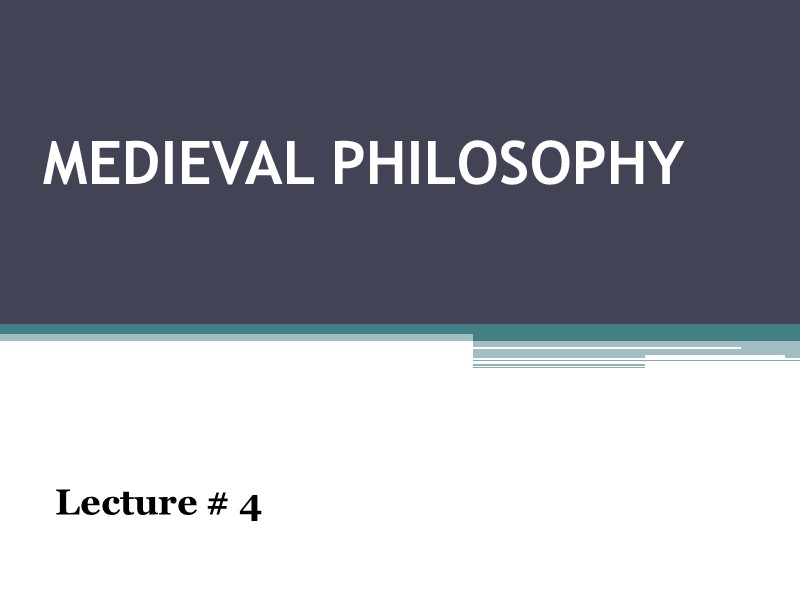
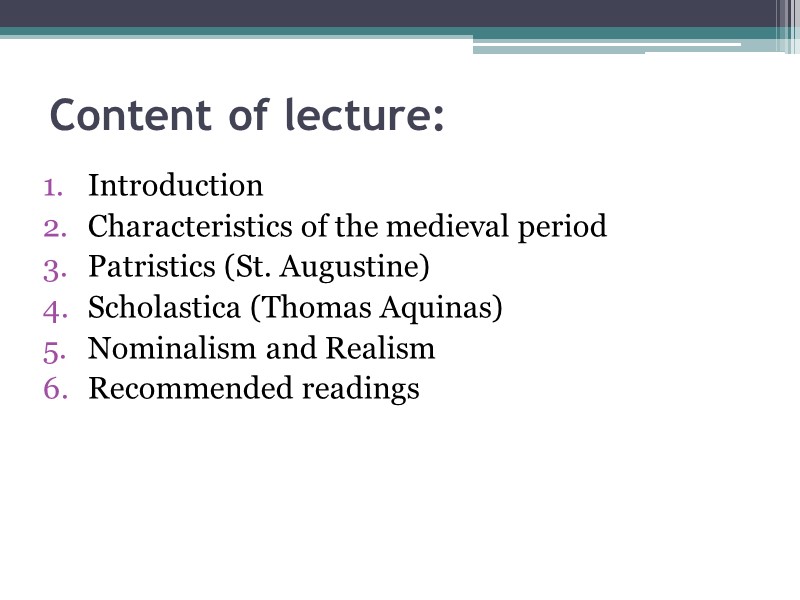
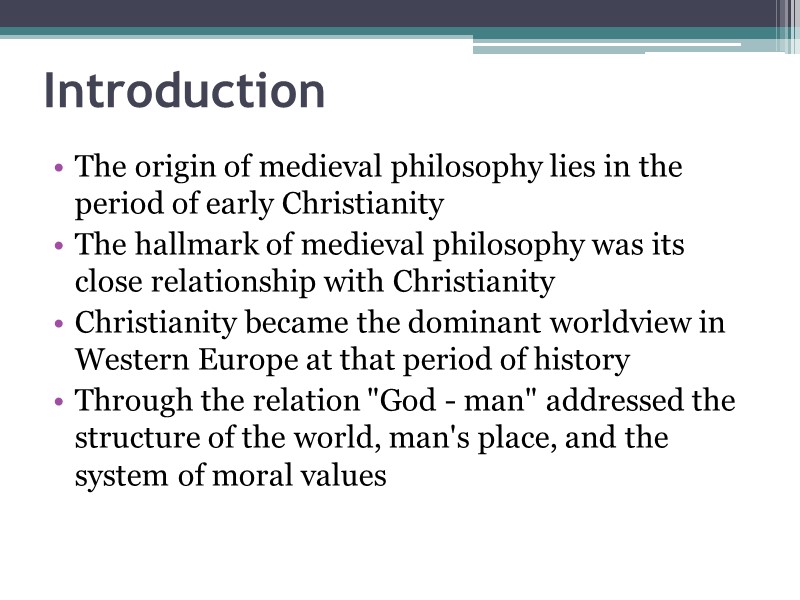


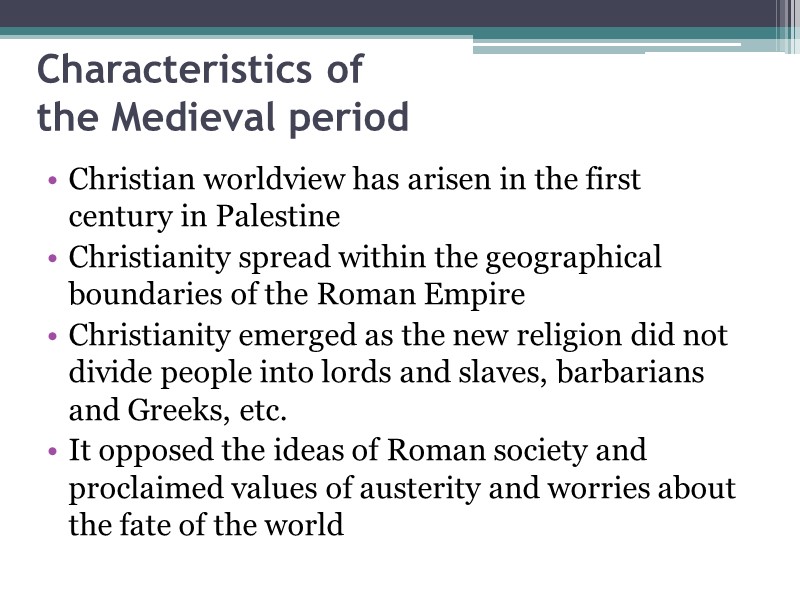
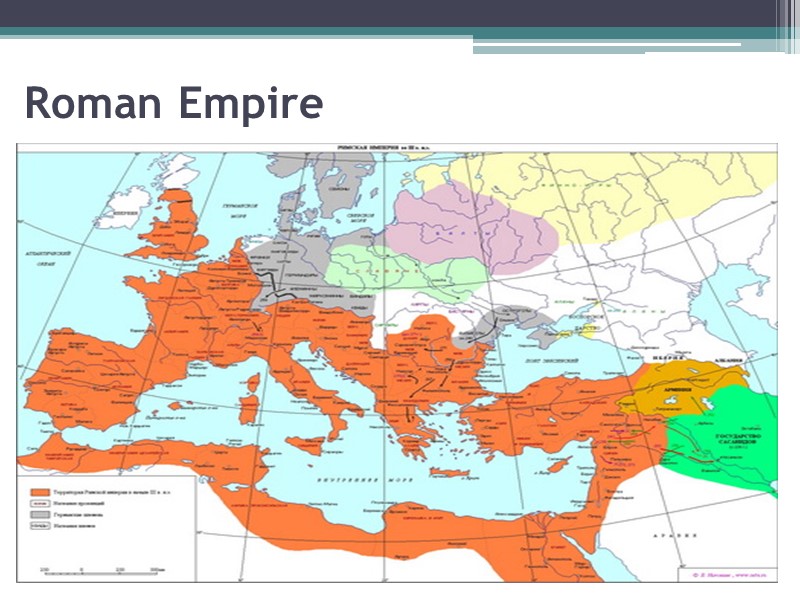
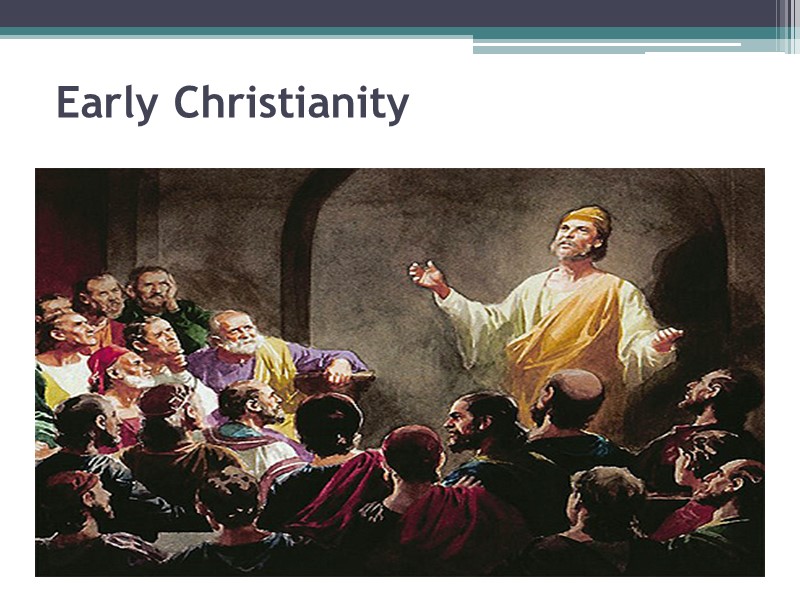
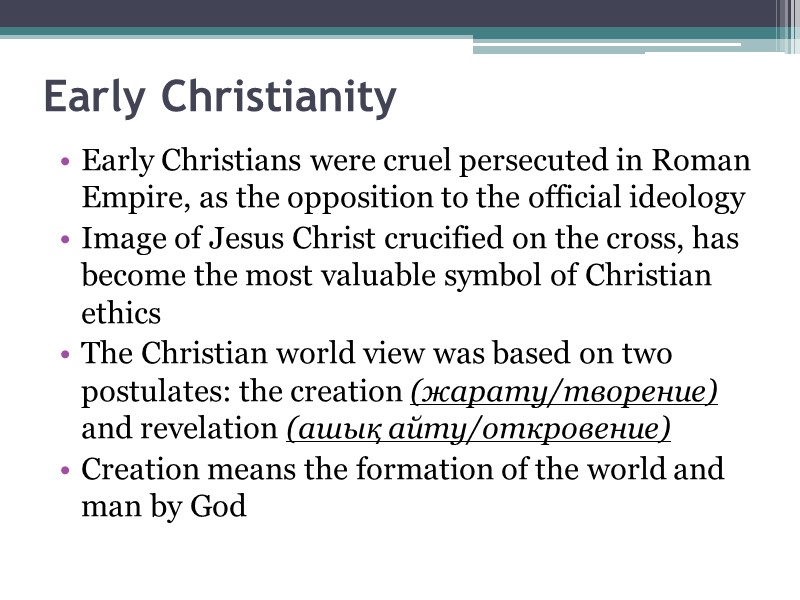

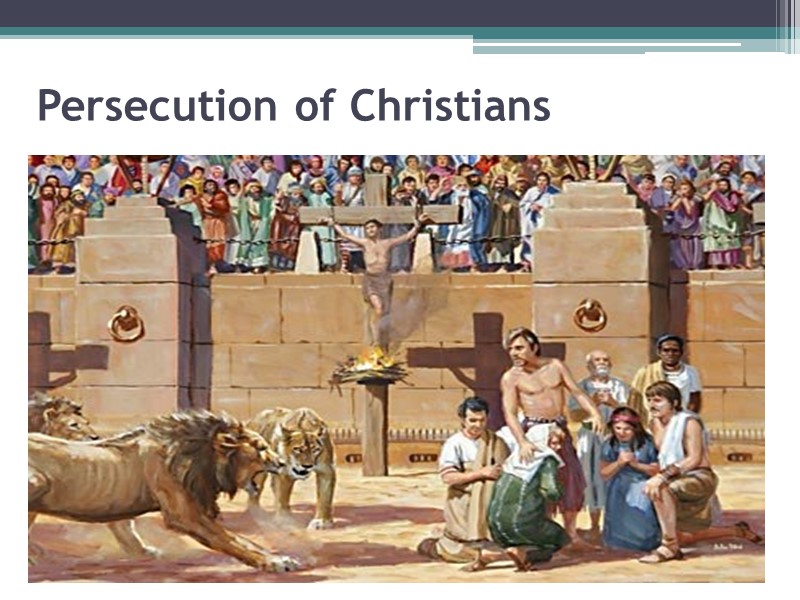
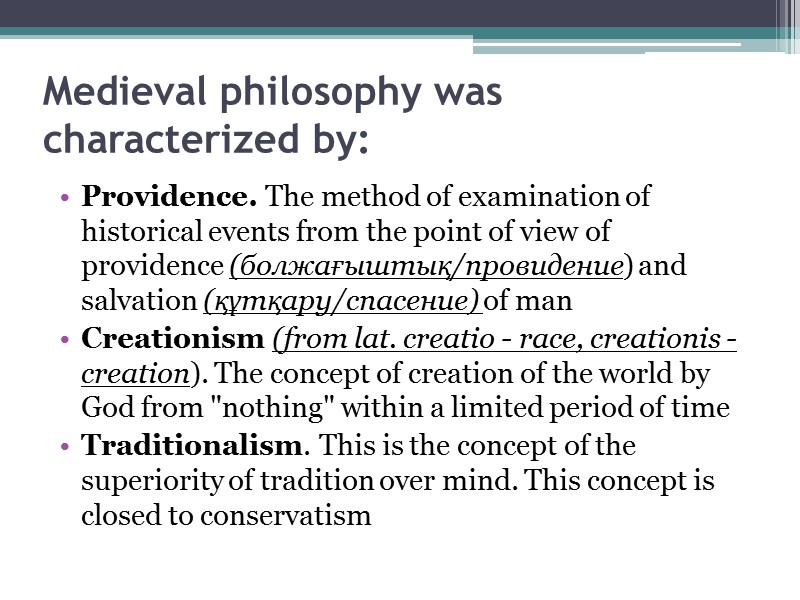
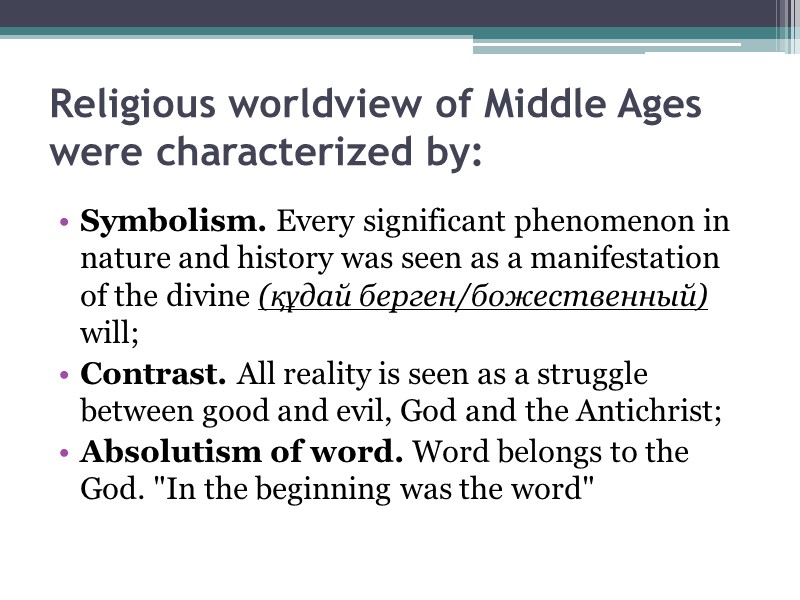
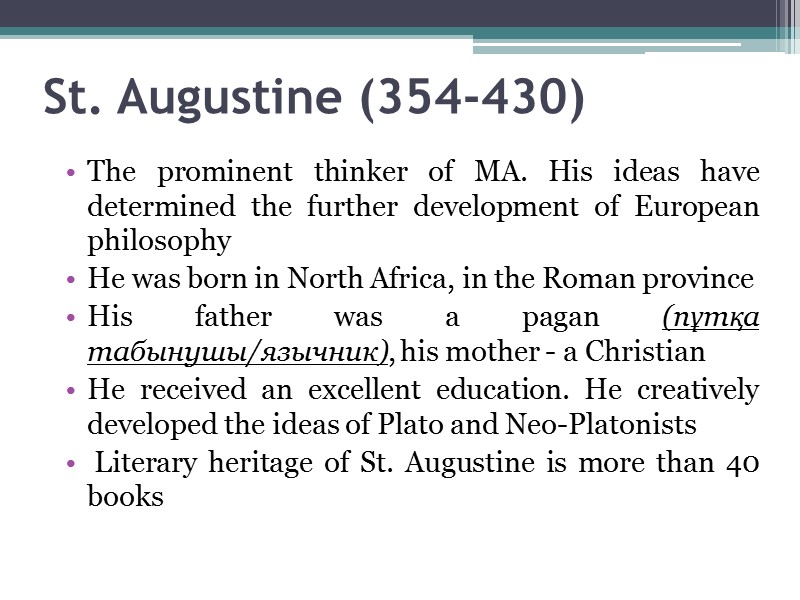
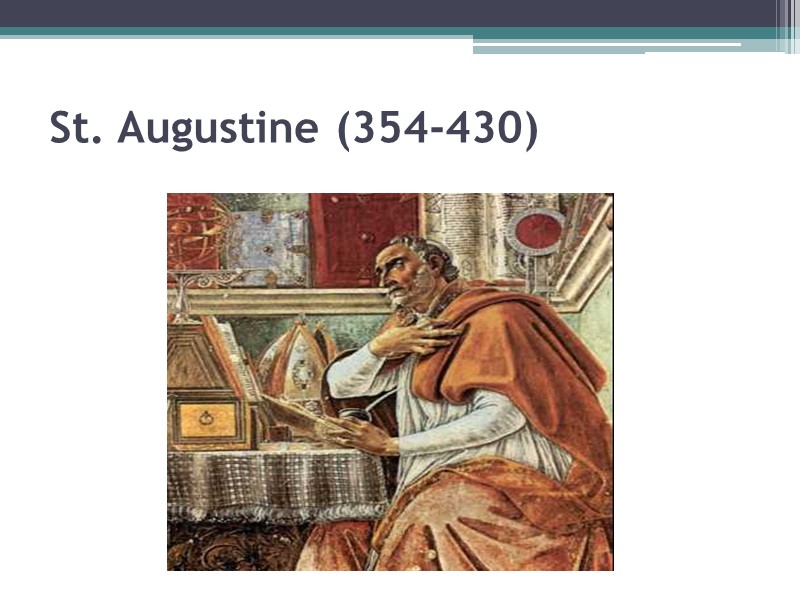
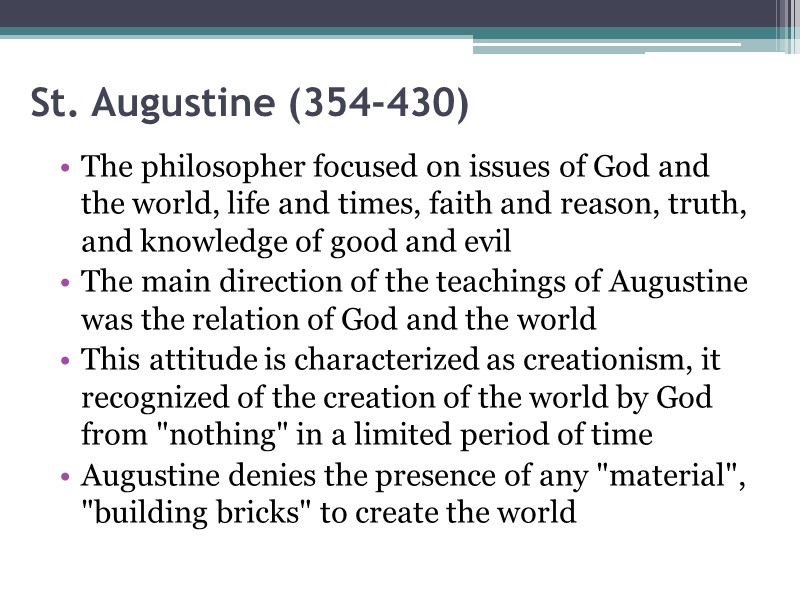
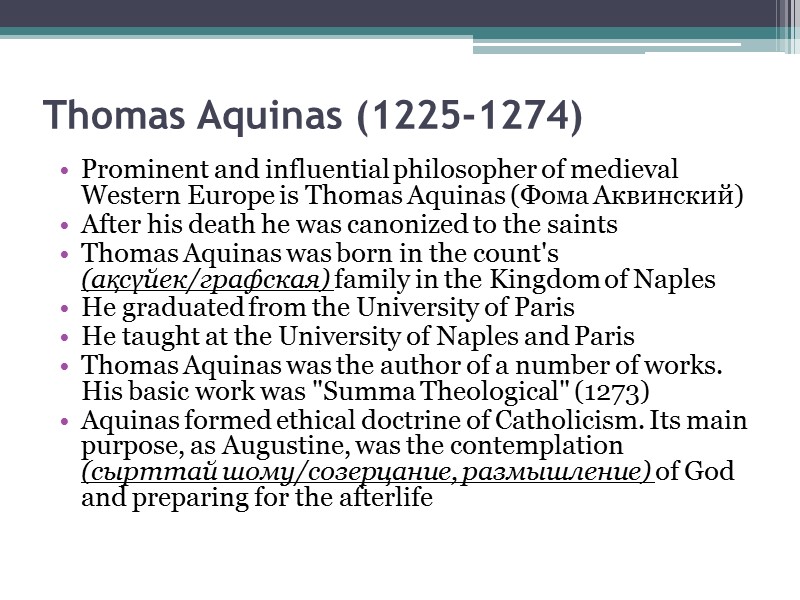
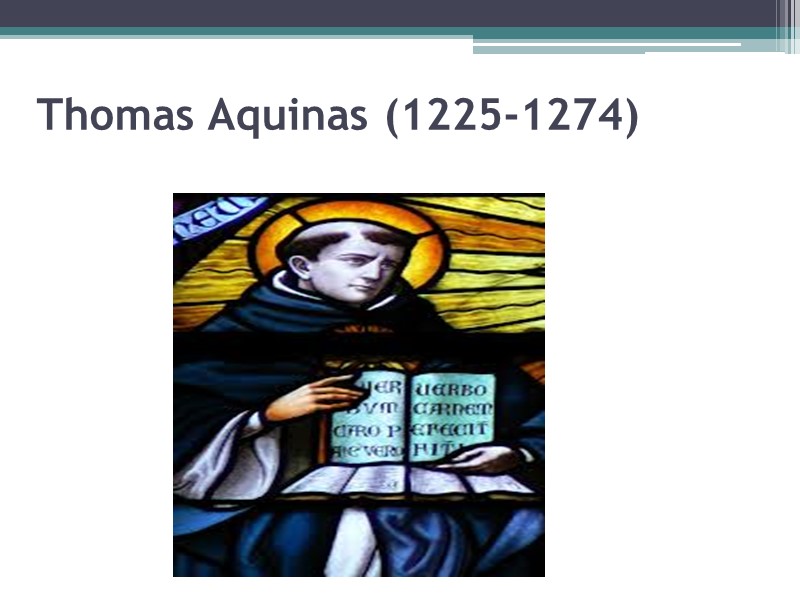
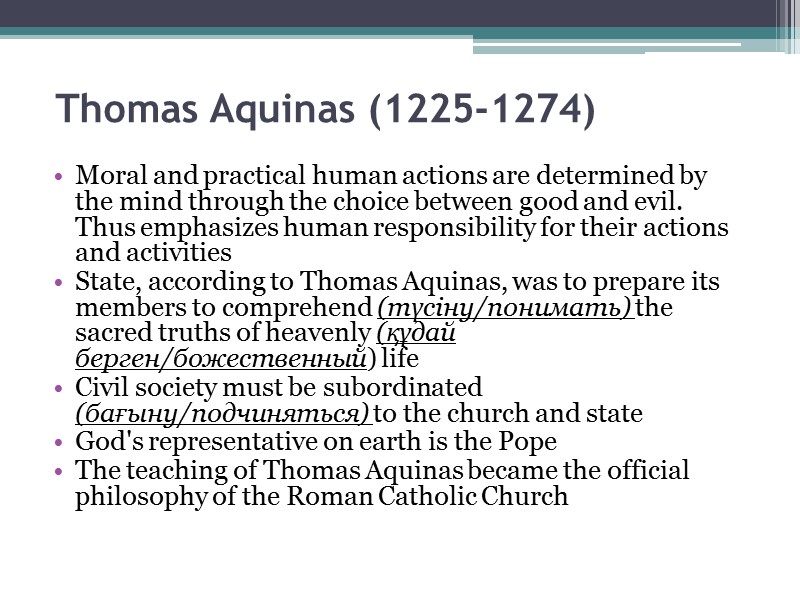
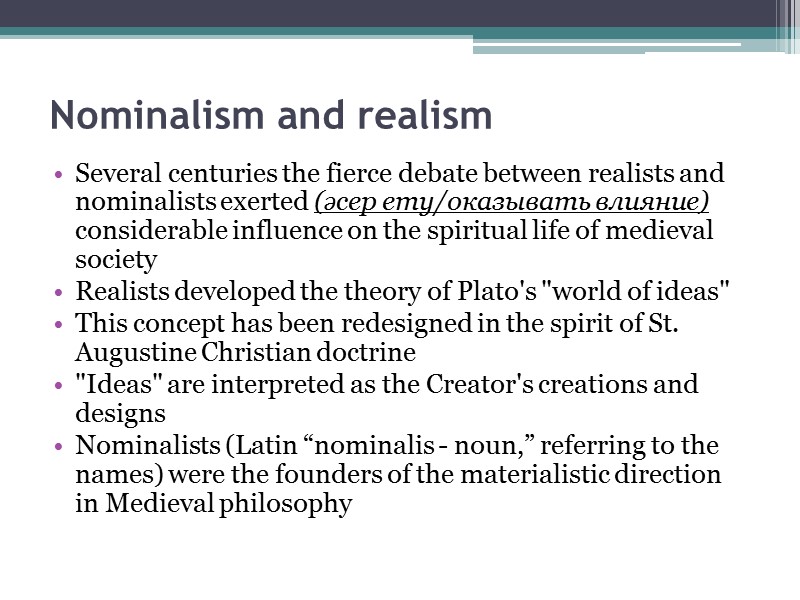
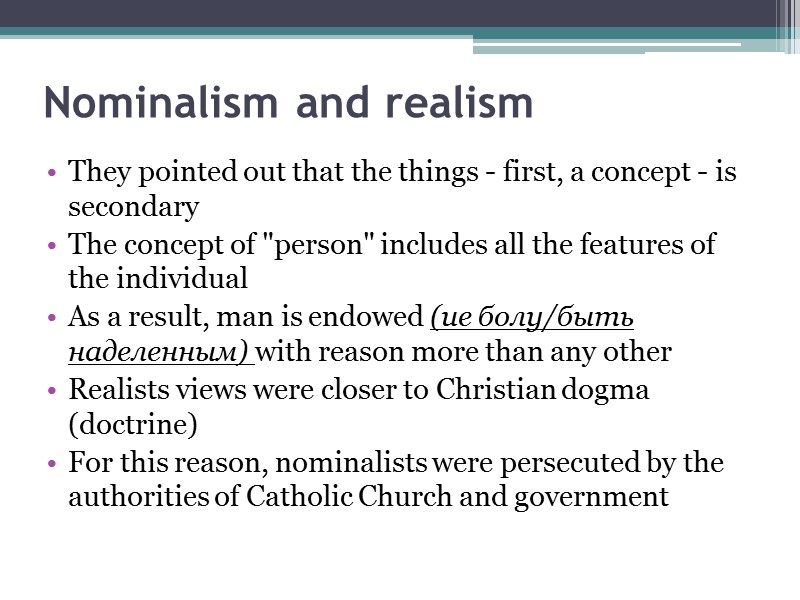
26746-phil-pp-l-_4._medieval.ppt
- Количество слайдов: 21
 MEDIEVAL PHILOSOPHY Lecture # 4
MEDIEVAL PHILOSOPHY Lecture # 4
 Content of lecture: Introduction Characteristics of the medieval period Patristics (St. Augustine) Scholastica (Thomas Aquinas) Nominalism and Realism Recommended readings
Content of lecture: Introduction Characteristics of the medieval period Patristics (St. Augustine) Scholastica (Thomas Aquinas) Nominalism and Realism Recommended readings
 Introduction The origin of medieval philosophy lies in the period of early Christianity The hallmark of medieval philosophy was its close relationship with Christianity Christianity became the dominant worldview in Western Europe at that period of history Through the relation "God - man" addressed the structure of the world, man's place, and the system of moral values
Introduction The origin of medieval philosophy lies in the period of early Christianity The hallmark of medieval philosophy was its close relationship with Christianity Christianity became the dominant worldview in Western Europe at that period of history Through the relation "God - man" addressed the structure of the world, man's place, and the system of moral values
 Introduction Therefore, medieval philosophy had theocentric character (the Greek word - theos - God) The main function of medieval philosophy was justification of religious precepts (уағыздар/постулаты) According to many historians, the philosophy of the period turned into a “servant of theology” There were two main periods in the development of medieval philosophy in Europe: the patristic and scholastic
Introduction Therefore, medieval philosophy had theocentric character (the Greek word - theos - God) The main function of medieval philosophy was justification of religious precepts (уағыздар/постулаты) According to many historians, the philosophy of the period turned into a “servant of theology” There were two main periods in the development of medieval philosophy in Europe: the patristic and scholastic
 Patristics and scholastica Patristics (Latin word “pater” – “father”) - a set of theological and philosophical doctrines of Christian thinkers of II-VIII centuries Scholastica (Latin word “scholastica” – “school”, “scholar”) defines a central role in the justification of the theological philosophy of dogmas (IX-XII centuries) Opposing positions to patristicism and scholasticism appeared in realism and nominalism At the heart of these conflicts was the confrontation of faith (наным/сенім/вера) and knowledge Dogma (догма) - учение, объявленное истиной и не подлежащее критике
Patristics and scholastica Patristics (Latin word “pater” – “father”) - a set of theological and philosophical doctrines of Christian thinkers of II-VIII centuries Scholastica (Latin word “scholastica” – “school”, “scholar”) defines a central role in the justification of the theological philosophy of dogmas (IX-XII centuries) Opposing positions to patristicism and scholasticism appeared in realism and nominalism At the heart of these conflicts was the confrontation of faith (наным/сенім/вера) and knowledge Dogma (догма) - учение, объявленное истиной и не подлежащее критике
 Characteristics of the Medieval period Christian worldview has arisen in the first century in Palestine Christianity spread within the geographical boundaries of the Roman Empire Christianity emerged as the new religion did not divide people into lords and slaves, barbarians and Greeks, etc. It opposed the ideas of Roman society and proclaimed values of austerity and worries about the fate of the world
Characteristics of the Medieval period Christian worldview has arisen in the first century in Palestine Christianity spread within the geographical boundaries of the Roman Empire Christianity emerged as the new religion did not divide people into lords and slaves, barbarians and Greeks, etc. It opposed the ideas of Roman society and proclaimed values of austerity and worries about the fate of the world
 Roman Empire
Roman Empire
 Early Christianity
Early Christianity
 Early Christianity Early Christians were cruel persecuted in Roman Empire, as the opposition to the official ideology Image of Jesus Christ crucified on the cross, has become the most valuable symbol of Christian ethics The Christian world view was based on two postulates: the creation (жарату/творение) and revelation (ашық айту/откровение) Creation means the formation of the world and man by God
Early Christianity Early Christians were cruel persecuted in Roman Empire, as the opposition to the official ideology Image of Jesus Christ crucified on the cross, has become the most valuable symbol of Christian ethics The Christian world view was based on two postulates: the creation (жарату/творение) and revelation (ашық айту/откровение) Creation means the formation of the world and man by God
 Crucifixion of Christ
Crucifixion of Christ
 Persecution of Christians
Persecution of Christians
 Medieval philosophy was characterized by: Providence. The method of examination of historical events from the point of view of providence (болжағыштық/провидение) and salvation (құтқару/спасение) of man Creationism (from lat. creatio - race, creationis - creation). The concept of creation of the world by God from "nothing" within a limited period of time Traditionalism. This is the concept of the superiority of tradition over mind. This concept is closed to conservatism
Medieval philosophy was characterized by: Providence. The method of examination of historical events from the point of view of providence (болжағыштық/провидение) and salvation (құтқару/спасение) of man Creationism (from lat. creatio - race, creationis - creation). The concept of creation of the world by God from "nothing" within a limited period of time Traditionalism. This is the concept of the superiority of tradition over mind. This concept is closed to conservatism
 Religious worldview of Middle Ages were characterized by: Symbolism. Every significant phenomenon in nature and history was seen as a manifestation of the divine (құдай берген/божественный) will; Contrast. All reality is seen as a struggle between good and evil, God and the Antichrist; Absolutism of word. Word belongs to the God. "In the beginning was the word"
Religious worldview of Middle Ages were characterized by: Symbolism. Every significant phenomenon in nature and history was seen as a manifestation of the divine (құдай берген/божественный) will; Contrast. All reality is seen as a struggle between good and evil, God and the Antichrist; Absolutism of word. Word belongs to the God. "In the beginning was the word"
 St. Augustine (354-430) The prominent thinker of MA. His ideas have determined the further development of European philosophy He was born in North Africa, in the Roman province His father was a pagan (пұтқа табынушы/язычник), his mother - a Christian He received an excellent education. He creatively developed the ideas of Plato and Neo-Platonists Literary heritage of St. Augustine is more than 40 books
St. Augustine (354-430) The prominent thinker of MA. His ideas have determined the further development of European philosophy He was born in North Africa, in the Roman province His father was a pagan (пұтқа табынушы/язычник), his mother - a Christian He received an excellent education. He creatively developed the ideas of Plato and Neo-Platonists Literary heritage of St. Augustine is more than 40 books
 St. Augustine (354-430)
St. Augustine (354-430)
 St. Augustine (354-430) The philosopher focused on issues of God and the world, life and times, faith and reason, truth, and knowledge of good and evil The main direction of the teachings of Augustine was the relation of God and the world This attitude is characterized as creationism, it recognized of the creation of the world by God from "nothing" in a limited period of time Augustine denies the presence of any "material", "building bricks" to create the world
St. Augustine (354-430) The philosopher focused on issues of God and the world, life and times, faith and reason, truth, and knowledge of good and evil The main direction of the teachings of Augustine was the relation of God and the world This attitude is characterized as creationism, it recognized of the creation of the world by God from "nothing" in a limited period of time Augustine denies the presence of any "material", "building bricks" to create the world
 Thomas Aquinas (1225-1274) Prominent and influential philosopher of medieval Western Europe is Thomas Aquinas (Фома Аквинский) After his death he was canonized to the saints Thomas Aquinas was born in the count's (ақсүйек/графская) family in the Kingdom of Naples He graduated from the University of Paris He taught at the University of Naples and Paris Thomas Aquinas was the author of a number of works. His basic work was "Summa Theological" (1273) Aquinas formed ethical doctrine of Catholicism. Its main purpose, as Augustine, was the contemplation (сырттай шому/созерцание, размышление) of God and preparing for the afterlife
Thomas Aquinas (1225-1274) Prominent and influential philosopher of medieval Western Europe is Thomas Aquinas (Фома Аквинский) After his death he was canonized to the saints Thomas Aquinas was born in the count's (ақсүйек/графская) family in the Kingdom of Naples He graduated from the University of Paris He taught at the University of Naples and Paris Thomas Aquinas was the author of a number of works. His basic work was "Summa Theological" (1273) Aquinas formed ethical doctrine of Catholicism. Its main purpose, as Augustine, was the contemplation (сырттай шому/созерцание, размышление) of God and preparing for the afterlife
 Thomas Aquinas (1225-1274)
Thomas Aquinas (1225-1274)
 Thomas Aquinas (1225-1274) Moral and practical human actions are determined by the mind through the choice between good and evil. Thus emphasizes human responsibility for their actions and activities State, according to Thomas Aquinas, was to prepare its members to comprehend (түсіну/понимать) the sacred truths of heavenly (құдай берген/божественный) life Civil society must be subordinated (бағыну/подчиняться) to the church and state God's representative on earth is the Pope The teaching of Thomas Aquinas became the official philosophy of the Roman Catholic Church
Thomas Aquinas (1225-1274) Moral and practical human actions are determined by the mind through the choice between good and evil. Thus emphasizes human responsibility for their actions and activities State, according to Thomas Aquinas, was to prepare its members to comprehend (түсіну/понимать) the sacred truths of heavenly (құдай берген/божественный) life Civil society must be subordinated (бағыну/подчиняться) to the church and state God's representative on earth is the Pope The teaching of Thomas Aquinas became the official philosophy of the Roman Catholic Church
 Nominalism and realism Several centuries the fierce debate between realists and nominalists exerted (әсер ету/оказывать влияние) considerable influence on the spiritual life of medieval society Realists developed the theory of Plato's "world of ideas" This concept has been redesigned in the spirit of St. Augustine Christian doctrine "Ideas" are interpreted as the Creator's creations and designs Nominalists (Latin “nominalis - noun,” referring to the names) were the founders of the materialistic direction in Medieval philosophy
Nominalism and realism Several centuries the fierce debate between realists and nominalists exerted (әсер ету/оказывать влияние) considerable influence on the spiritual life of medieval society Realists developed the theory of Plato's "world of ideas" This concept has been redesigned in the spirit of St. Augustine Christian doctrine "Ideas" are interpreted as the Creator's creations and designs Nominalists (Latin “nominalis - noun,” referring to the names) were the founders of the materialistic direction in Medieval philosophy
 Nominalism and realism They pointed out that the things - first, a concept - is secondary The concept of "person" includes all the features of the individual As a result, man is endowed (ие болу/быть наделенным) with reason more than any other Realists views were closer to Christian dogma (doctrine) For this reason, nominalists were persecuted by the authorities of Catholic Church and government
Nominalism and realism They pointed out that the things - first, a concept - is secondary The concept of "person" includes all the features of the individual As a result, man is endowed (ие болу/быть наделенным) with reason more than any other Realists views were closer to Christian dogma (doctrine) For this reason, nominalists were persecuted by the authorities of Catholic Church and government

